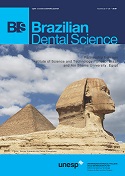Botulinum toxin for modulating the muscle strength of patients rehabilitated with zygomatic implants
DOI:
https://doi.org/10.14295/bds.2019.v22i2.1657Resumo
Objective: To measure the intensity of muscle strength and electrical activity of masseter and anterior temporal muscles based on BTX-A therapy in patients rehabilitated with total prostheses on zygomatic implants. Material and Methods: The object of the study was a sample of 20 individuals subjected to zygomatic implant surgery and rehabilitated with implant-supported prostheses, in order to obtain electromyographic data using an eight-channel module (EMG System do Brasil). The data were collected for three consecutive months: prior to the application (single dose) of BTX-A (30 U/ masseter muscle; 10 U/temporal muscle) and after 30 and 90 days of therapeutic treatment. Result: All muscle groups studied showed reduction of muscle electrical activity during voluntary contraction after 30 days of treatment (around 47%) (p < 0.001), which progressively reverted after 90 days of treatment. The anterior temporal muscles presented similar motor behavior, with activity reduction of 39% (p < 0.05). There was a reduction of 17.68% (p < 0.05) in mandibular force and an increase of 14.22% (p < 0.05) in mouth opening after 30 days of BTX-A administration. Conclusions: The results suggest that BTX-A significantly reduces muscle activity, in either the recruitment of motor units or muscle tone, in the first three months of therapeutic treatment. This therapy may also be useful as a preventive method for the failure of zygomatic implant-supported prostheses.
Keywords
Electromyography; Dental implants; Prostheses on implants; Botulinum toxin.
Keywords: Electromyogra phy; Dental implants; Prostheses on implants; Botulinum toxin.
Downloads
Downloads
Arquivos adicionais
Publicado
Como Citar
Edição
Seção
Licença
TRANSFERÊNCIA DE DIREITOS AUTORAIS E DECLARAÇÃO DE RESPONSABILIDADE
Toda a propriedade de direitos autorais do artigo "____________________________________________________________________" é transferido do autor(es) para a CIÊNCIA ODONTOLÓGICA BRASILEIRA, no caso do trabalho ser publicado. O artigo não foi publicado em outro lugar e não foi submetido simultaneamente para publicação em outra revista.
Vimos por meio deste, atestar que trabalho é original e não apresenta dados manipulados, fraude ou plágio. Fizemos contribuição científica significativa para o estudo e estamos cientes dos dados apresentados e de acordo com a versão final do artigo. Assumimos total responsabilidade pelos aspectos éticos do estudo.
Este texto deve ser impresso e assinado por todos os autores. A versão digitalizada deverá ser apresentada como arquivo suplementar durante o processo de submissão.




























